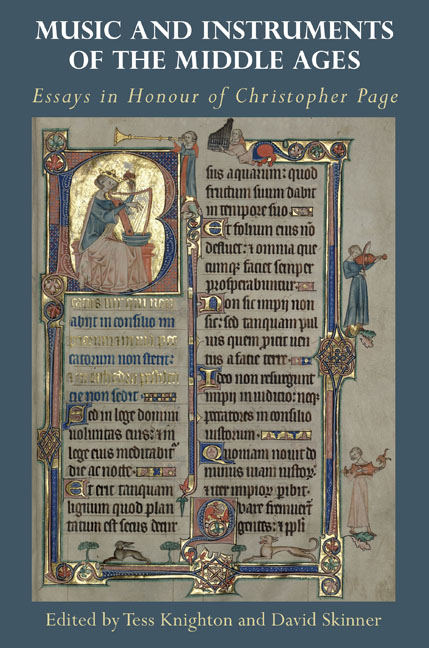Book contents
- Frontmatter
- Contents
- List of Illustrations
- List of Music Examples
- List of Tables
- List of Contributors
- List of Music Manuscript Sigla
- Acknowledgements
- Introduction
- SONGSTERS AND THEIR REPERTORIES
- CLOSE READINGS
- CREATING POLYPHONY
- MUSIC AS CULTURAL PRACTICE
- Works Cited
- Works by Christopher Page
- Index
- Tabula Gratulatoria
- Studies in Medieval and Renaissance Music
3 - The Estampies of Douce 308
Published online by Cambridge University Press: 24 November 2020
- Frontmatter
- Contents
- List of Illustrations
- List of Music Examples
- List of Tables
- List of Contributors
- List of Music Manuscript Sigla
- Acknowledgements
- Introduction
- SONGSTERS AND THEIR REPERTORIES
- CLOSE READINGS
- CREATING POLYPHONY
- MUSIC AS CULTURAL PRACTICE
- Works Cited
- Works by Christopher Page
- Index
- Tabula Gratulatoria
- Studies in Medieval and Renaissance Music
Summary
The medieval estampie has been variously characterised in modern scholarship as a form, a genre, or merely a concept. Its medieval descriptions in music theory and poetic treatises, as well as in literary works, are difficult to interpret, appear to describe slightly different formal types, and are seemingly incompatible. Brief mentions in music treatises by Guido of Saint-Denis and Robertus de Handlo do not provide significant clarification: the most extensive discussion is that of Johannes Grocheio, a theoretical outlier writing in Paris around 1300, who applies the term to both instrumental and vocal dances. Timothy J. McGee's attempt to harmonise Grocheio's work with the surviving examples discusses the terms of Grocheio's descriptions and problems of their interpretation; similar attempts earlier by Lloyd Hibberd and later by Elizabeth Aubrey and Robert Mullally all offer slightly different conclusions.
The surviving examples of estampies present further challenges. Attempts to harmonise the medieval theoretical discussion with surviving works have been hampered not only by lack of clarity in the theoretical writings, but also by the unevenness of musical notation, patchiness and unclear generic labelling of the surviving examples, and by the disciplinary preconceptions of modern scholars. Editions of poetic texts typically disregard the surviving textless examples, whereas, as Christiane Schima noted, musicologists have concentrated disproportionately on the untexted, instrumental examples because very few of the texted ones have any musical notation.
Schima's 1995 Utrecht doctoral dissertation is, despite the rapid provision of online access to sources, unfortunately still of limited availability, yet is the fullest and best scholarly resource for the estampie currently available. In German (with a Dutch summary), it has been largely neglected in Anglophone scholarship in favour of the work of McGee. As well as being the author of the Grove entry on the estampie, McGee's ring-bound publication of editions of the surviving notated repertory has, notwithstanding some reviewers’ reservations about its accuracy and rhythmic interpretations, become an important resource for recorded performances. McGee exemplifies the relative neglect of the vocal estampies that Schima describes: while he includes the two notated vocal estampies at the head of his edition, he does not give details of the unnotated ones.
- Type
- Chapter
- Information
- Music and Instruments of the Middle AgesEssays in Honour of Christopher Page, pp. 77 - 118Publisher: Boydell & BrewerPrint publication year: 2020

